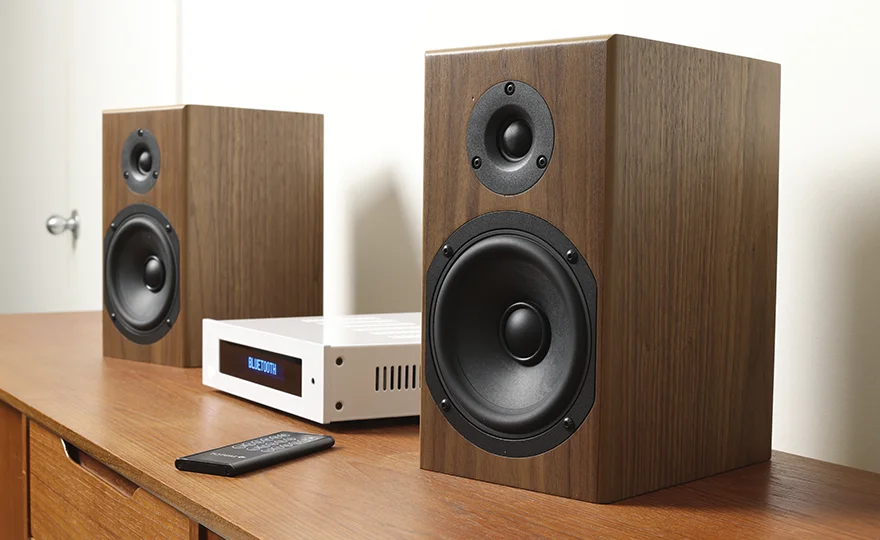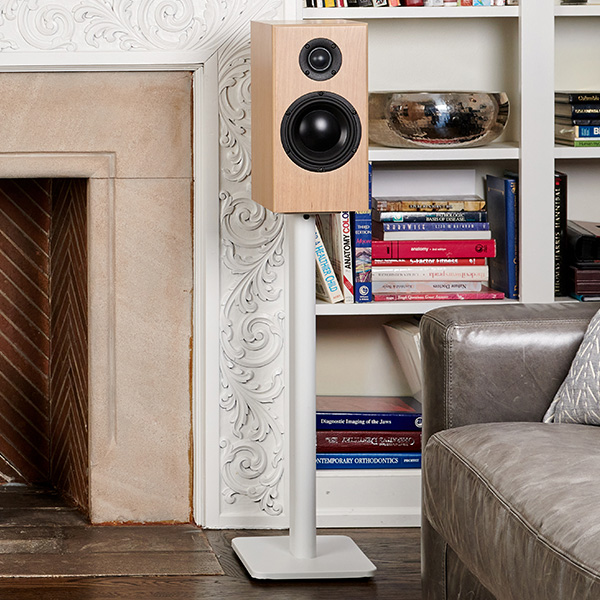When it comes to setting up the perfect sound system for a small room, one of the most important decisions is choosing between bookshelf speakers with a subwoofer or floorstanding speakers. Both options are capable of providing rich, detailed sound, but the best choice depends on the size and acoustics of the room, your listening preferences, and the types of music you enjoy. In this article, we will compare the two setups, explore their benefits, and help you determine which configuration is ideal for your space.
The Appeal of Bookshelf Speakers with a Subwoofer
Bookshelf speakers have long been a favourite for audiophiles due to their compact size, accurate sound reproduction, soundstaging precision and versatility. When paired with a subwoofer, these speakers become a powerful option for small rooms that require a bit of extra bass without overwhelming the space. The addition of a subwoofer can elevate your listening experience by providing deep, rumbling lows that bookshelf speakers alone might struggle to produce.
Many audiophiles enjoy the crisp, high-end details that come from bookshelf speakers, such as the shimmering cymbals in Pink Floyd’s “Shine On You Crazy Diamond” or the intricate guitar work in Fleet Foxes’ “White Winter Hymnal.” The presence of a subwoofer in this setup will ensure that you also hear and feel the full impact of the low-end frequencies in genres like electronic, rock, or hip-hop. With proper placement of the speakers and subwoofer, you can create an immersive experience without taking up much floor space.
Benefits of Bookshelf Speakers + Subwoofer for Small Rooms
- Sound Quality: Bookshelf speakers are well-loved for their ability to produce a clear and detailed sound, especially in the midrange and high frequencies. They are also preferred by audiophiles for their more precise imaging and more focused soundstaging, over floorstanding speakers. Equally as important, since bookshelf speakers are typically designed for smaller rooms, they can be less susceptible to room-related issues like standing waves and excessive bass reflections.
- Space Efficiency: Bookshelf speakers are typically compact, making them ideal for limited spaces. They are easy to place on a piece of furniture, stand, or mount on a wall without taking up floor space. This is particularly beneficial in a small room where every square foot counts.
- Customization with a Subwoofer: The subwoofer allows you to fine-tune your sound system by providing the ability to adjust bass levels independently of the bookshelf speakers. Whether you’re listening to the low-end growls of Led Zeppelin’s “Immigrant Song” or the subtle vibrations of a classic jazz track, a subwoofer adds depth to your sound without muddying the mids or highs.
- Flexibility: With a bookshelf speaker + subwoofer combo, you can always upgrade your subwoofer or speakers down the line, giving you the freedom to customize your setup over time. If you decide to move to a larger space, adding a bigger subwoofer or upgrading to larger bookshelf speakers can easily scale your system without completely overhauling it.
The Case for Floorstanding Speakers
Floorstanding speakers are larger and can provide a full-range sound experience, offering deeper bass and more balanced midrange frequencies than bookshelf speakers alone. In small rooms, however, their larger size can sometimes be a challenge, as they take up more floor space and may produce more bass than the room can accommodate. This can lead to issues with bass overload or room resonance, which could negatively affect the sound quality.
That said, many audiophiles who enjoy classical music, orchestral arrangements, or full-band performances might prefer the rich, enveloping sound that floorstanding speakers deliver. When listening to the intricate arrangements in “Baba O’Riley” by The Who or the expansive soundscapes in Radiohead’s “Everything In Its Right Place,” floorstanding speakers can provide a more dynamic and immersive listening experience.
Benefits of Floorstanding Speakers in Small Rooms
- Fuller Sound Without a Subwoofer: While bookshelf speakers benefit from a subwoofer to achieve the full frequency range, floorstanding speakers can often deliver all the bass, midrange, and treble you need without additional equipment. The larger drivers in floorstanding speakers allow them to produce deeper bass on their own, which can be a benefit for those who want a more minimalist setup.
- Larger Soundstage: Floorstanding speakers, due to their size and multiple drivers, often have a wider soundstage, meaning they can create a more expansive sound that fills the room. This is ideal for listeners who enjoy a broader, more enveloping experience, especially when listening to full-band albums like the upbeat funk grooves of Jamiroquai’s “Virtual Insanity” or the punchy rock energy of The Strokes’ “Reptilia.”
- Higher Power Handling: Floorstanding speakers can handle more power from an amplifier, which can be advantageous for audiophiles who enjoy listening to their music at higher volumes. Whether you’re cranking up the volume for a booming bassline in The Chemical Brothers’ “Block Rockin’ Beats” or the punchy drums in The Black Keys’ “Gold on the Ceiling,” floorstanding speakers are built to perform at higher levels without distortion.
Which Is Better for a Small Room?
When choosing between bookshelf speakers + subwoofer or floorstanding speakers for a small room, it really depends on your priorities.
- Space Considerations: If you’re working with limited space, bookshelf speakers with a subwoofer are likely the better choice. They take up less room while still delivering a dynamic, full-range sound.
- Bass Preferences: If you enjoy deep bass and don’t mind dedicating some space for a subwoofer, the bookshelf speaker + subwoofer combo offers great flexibility and customization.
- Soundstage and Volume: If you prefer a more expansive soundstage and listen to music at higher volumes, floorstanding speakers may be the way to go. However, make sure the room is acoustically suitable for larger speakers to prevent bass overload or muddiness.
Final Thoughts
In a small room, the choice between bookshelf speakers + subwoofer and floorstanding speakers ultimately boils down to what kind of sound experience you’re seeking. Bookshelf speakers paired with a subwoofer provide flexibility, space efficiency, and room for growth, while floorstanding speakers offer a more full-bodied, dynamic sound with less need for additional equipment.
If you’d like to learn more about the sound quality you can expect from floorstanding speakers versus bookshelf speakers, please check out this article we published recently which does a deep dive of this topic: Floorstanding vs. Bookshelf Speakers: Which Type of Speaker is Right for You?
If you’ve enjoyed this article and want to explore more about speaker setups, sound systems, and high-end audio, check out similar articles in our News + Reviews section. Whether you’re new to the world of audiophilia or a seasoned pro, we’ve got a range of content designed to help you achieve the ultimate listening experience in any space.

